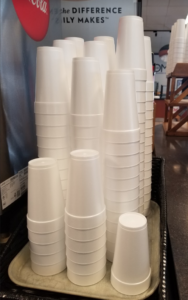The dishwashing machine was down in Marbeck on Friday, Feb. 7. As a response, Sodexo had to use plastic foam, also known as polystyrene foam or the brand name Styrofoam, and plasticware for the lunches served.
There were a variety of feelings toward walking into the mid-day meal and seeing the amounts of plastic foam stacked up at each food station. Many students didn’t think twice about the difference and used the plates, cups and utensils as they normally would; others felt uncomfortable but still used the products. Other students had responses that contained much frustration and disdain as they attempted to use as little of the dishware as they could.
The book required for the class seniors are required to take called Christian Values in a Global Community states that Bluffton University has made an environmental commitment adapted from the American College and University President’s Climate Commitment.
“As a place where we care about Christian Values in a Global Community, we must exercise leadership in our community and in society by modeling ways to minimize environmental impact, and by providing our graduates with the education and preparation necessary to achieve climate neutrality. Bluffton commits to addressing the climate challenge by reducing global warming emissions on our campus and by integrating sustainable practices into our curriculum and action,” states the “LAS 400: Christian Values in a Global Community book.”
Bluffton University still does not have a public statement directed towards its commitment to sustainability, but it still is integrated within various aspects of campus including the class curriculum. Because of the university’s stance on sustainability, it is important to hold each of its constituents to the same standard to make strides toward being more sustainable. While the event of the dishwashing machine in the kitchen being under repair does not happen often, it is not the first time within the academic school year that plastic and plastic foam has been Sodexo’s temporary solution to the problem.
Turning to Sodexo’s website, they pride themselves in taking strides to more sustainable living and serving by cutting down on food waste. This year, they will be implementing a plan called Leanpath, which is a technology that will help them measure their food waste so that they can assess how to adjust to what people are eating. They will weigh the leftover food that has to get thrown away at the end of the day so as to prepare better for the next meals.

Stacks of plastic foam cups are piled up high. Photo by Olivia Tennefoss.
In October of 2018, the company announced its launch of the “North American Single-Use Plastics Reduction Plan” that would reduce the usage of plastic straws greatly by using the “by request” policy, and they would eliminate their use of single-use plastics like bags and stirring utensils by 2019. Their next goal is to eliminate the use of Polystyrene foam [plastic foam] by 2025.
While that goal is still several years away, there are still active steps that can work towards quicker solutions. John Combs, the executive chef at Bluffton University, said they have already cut down on disposable items since they use washable dishes in the cafeteria. He hopes to continue to reach for Sodexo’s 2025 goals by starting to look at some biodegradable options, but up to now their reason for not using them is because of the extreme difference in prices between plastic foam and alternate disposable dishes.
Combs said on Sodexo’s side of things, they still have to complete their contracts with their companies that provide some of these plastic foam materials, but as those contracts start closing, they will approach the company and talk about options for using paper or some type of biodegradable material and what deals they can get to make the price come down and more affordable to choose something more sustainable.
Plastic foam products are an extremely cheap product made up of 98% air, but according to Sciencing.com, the product does not decompose under natural conditions. For perspective, plastic takes hundreds of years to eventually decompose, but plastic foam takes much longer than that to decompose because it is a stronger plastic.
According to the science website, there are methods that can break down plastic foam like direct sunlight over the course of several months or with high heat. But then there are still several problems that accompany it including the harsh chemicals that come out of it as it breaks down, and the small pieces that animals eat during the plastic foam’s breakdown. However, with the majority of plastic foam going into landfills, it doesn’t reach these conditions. According to Sciencing.com, plastic foam and other plastics make up 30 percent of landfills in the United States.

President of the Sustainability Club Cassie Reinhart. Photo by Olivia Tennefoss.
Cassie Reinhart, a senior speech-language pathology student and president of the Sustainability Club, brought up the prospect of if the dishwashing machine hadn’t been fixed before the next meal and had lasted several days.
“If the dishwasher was out for a whole week and we use Styrofoam [plastic foam] for a whole week, that creates so much waste,” said Reinhart. “It just sits and sits and it never really decomposes. Our one small university is contributing so much in that week to the landfill issues that are happening right now. So I feel like it kind of relays the message that they don’t care about the environment.”
Something else that is presented on Sodexo’s website is a quote from Jill Houghton, President & CEO of the organization Disability: IN, saying that these products like plastics and plastic foam aren’t considered as convenience products for many people, they’re considered as necessities.
That one sentence alone can serve as an example of how the mindset of people, especially Americans, has to change. These are not products that are necessary for our day-to-day lives, but they are convenience products that can help you save a few dollars here and there when you decide to not use paper products.
The way things work here at Bluffton, students use what they are given. It’s up to the foodservice providers to make the decision of using paper over the plastic foam and plastic products. Changing the “grocery list” and adjusting the budget would make an impact.
From the business standpoint of Sodexo, their long-range goal of cutting down polystyrene foam [plastic foam] by 2025 can be understood so that they can cover their bases. However, there are still substantial steps that can be taken immediately, and that is referencing their website’s statement of “starting with immediate reductions.”
These immediate reductions, however, can’t be seen while the plastic foam products are still being used when the reusable dishes are not available. Combs’ interest in looking for some biodegradable alternatives to use for next time, as well as figuring out how to fit that in the budget, offers hope that some change could happen soon while Sodexo is still obligated to follow through with its contracts.

Plastic foam dishes fill up the trash bags quickly. Photo by Olivia Tennefoss.
Reinhart suggested methods that the cafeteria could use to better the situation like figuring out a way where they might be able to send out an email to the students to inform them of the dishwasher situation and suggest that they bring their own cups, plates or silverware. She doesn’t expect that all students would bring their own dishes, but it would at least be a step in the right direction.
“I feel like if they advertised it, then maybe students could make a change,” said Reinhart. “I feel like that’s at least an effort. It’s showing that like, ‘Yeah we’re admitting we’re using disposable stuff, [but] we’re giving you another option, an alternative.’”







